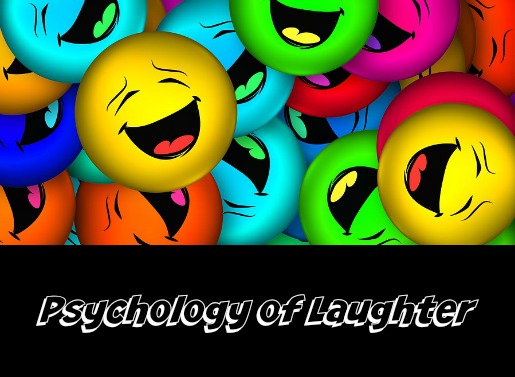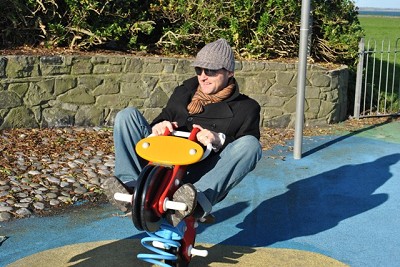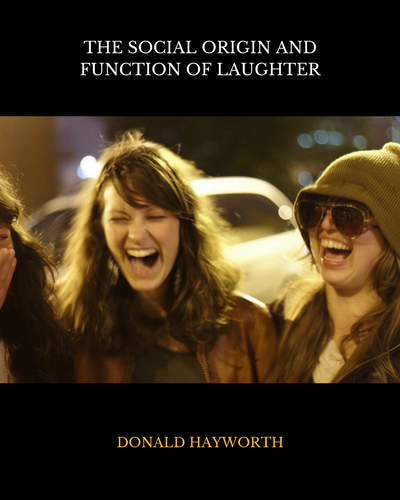Psychology of Laughter by Glen Duggan
Glen Duggan is a happily married father of three children, whom he describes as 'the best in the world'. Glen graduated with a B.Sc. (Hons) in psychology from the Open University, after which he completed a M.Sc. in Applied Psychology, with Trinity College, Dublin. He is currently working towards achieving a PhD in Psychology, again with Trinity College, only this time he's researching laughter, which he considers to be the most fantastic PhD subject imaginable.
In his spare time he hosts an educational & fun Podcast, called The Laughter Research Podcast, which is dedicated to the discussion of laughter. It can be found at www.laughterresearch.com, or on iTunes.
(Glen researching laughter in a naturalistic setting)
Laughter: Don't Sweat The Small Stuff
Laughter is commonly interpreted as a universally recognised social signal of joy and mirth. Often, this is indeed the case. However, I wish to propose that laughter is much more than that. Through my ongoing PhD research, I have come to understand laughter as a behaviour which serves to negotiate states of discordance. These discordances are varied and wide ranging. For instance, they could be social, in the case of an awkward social interaction, physiological, such as in the case of laughter buffering the experience of pain, or psychological, in terms of shifting a spike in emotional arousal to a state which is closer to a state of emotional balance. At times, laughter can serve to manage multiple discordances at once.
|
To begin with the latter two for example, at the earliest stages of my research and in contradiction to my initially emerging thoughts that laughter may be an entirely social phenomenon, a participant (pseudonym Patricia) described in a research interview how she had recently walked into a closed glass patio door, whilst in a solitary setting and how she laughed out loud as a consequence. |
|
In this case, as there was no one else present, the laughter was clearly not a social signal to an onlooker. Indeed, when questioned specifically about such a hypothesis, she reported that she was not thinking of what other people would think of her for having walked into the glass. Essentially, this incident could not be interpreted as Patricia trying to cover up her embarrassment, even if it the cover up were to an imagined audience. Hence, the laughter could accurately be described as reactive to the circumstance.
This incident contradicted my initial preconception that laughter was an entirely social phenomenon. The memory of this early interview remained with me and it was troubling for some time during my research journey, as I was trying (in complete conflict with the Grounded Theory approach I was using) to wedge my belief that there must be some social factor underlying her laughter. Unbeknownst to myself, I was hoping that evidence would emerge to support this notion. It wasn't until I grew more confident in my abilities as a Grounded Theory researcher that I could let go of my preconceived social explanation for laughter. This allowed for the emergence of the discordance negotiation concept referred to above.
As per the experiences and teachings of Glaser & Strauss, the developers of the Grounded Theory method [1], not all processes are evident to the participants in the action scene, yet the researcher can make sense of these latent processes with the benefit of a broad grounded evidence base. Whilst the lady who walked into the glass patio door did not offer any explanation for the laughter other than "it was funny", over time the combined evidence of my research has exposed a latent pattern, in which laughter often (but not always, as will be expanded upon later) occurs after tensions have arisen. While some people say that they 'feel better' after laughter, most are not prone, in their typical day, to giving laughter any further conscious analysis. Laughter may well be obvious in its presentation, but it is not obvious in its functioning.
'Funniness'
An explanation that the event was just 'funny', appealing as it is, is dependent upon the elusive concept of 'sense of humour'. This explanation, in isolation, fails when one gives consideration to the fact that what is funny for one person, is not funny for another. Funniness, without further elaboration, cannot offer a satisfactory explanation. Furthermore, whether one has a 'good sense of humour' or not, there are many other context dependent alternatives to handling the accident, as laughter is highly contingent upon other factors and may not occur in all cases. An example of such a contingent factor is the extent of the injury. A light bump may result in laughter, whilst a bloodied nose may not. Time is another factor, as with the passing of time (and consequently, the reduction of the associated stress), even a bloodied nose can become a source of laughter. Such contextual factors are crucially important in predicating whether reactive laughter is available to the individual as a discordance negotiation tool.
My interpretation, which is supported by further grounded data gathered throughout my PhD research, is that when laughter performs the innate function of negotiating discordances, people don't need to be cognisant of its effects, no more than people need to analyse why it was that they withdrew their hand from a hot surface. Now, with the benefit of the supporting grounded evidence, I surmise that the laughter emitted in response to the patio door incident implicitly served the purpose of negotiating the psychological obstacle of the mild emotional tension associated with the minor accident which Patricia experienced. Consequently, reactive laughter can be thought of in terms of an emotional recalibration device.
Crying - A Close Relative of Laughter
In this sense, laughter shares striking similarities to crying, a close relative in terms of emotional recalibration. We've all heard versions of the expression 'I didn't know whether to laugh or cry'. There is a valid reason for this - laughter is useful, but only up to a point. If the discordance is too great, then an alternative course of action may be more adaptive. Sometimes the more appropriate reaction might be crying, at other times it might be fleeing. The difference is a matter of degrees. It is only when the discordance, such as the fear caused by a loud bang for instance, has subsided due to an evaluation of the level of threat, that the laugh or cry option becomes available. Some people burst into tears after a fright, while others begin to laugh.
Refining The Use of Laughter
Laughter is an ability which all typically developing people have, yet our ability to bounce back from challenges as an adult by means of laughter may well be a skill which we hone at a very early age and this is incorporated into our personal range for laughter. Even infants who are born deaf and blind laugh for the first time around the same age of 3-4 months, just as with typically developing infants [2], so the act of laughing, in and of itself, is not a learned behaviour. Under what circumstances it is useful to use laughter, is something which we do obtain guidance on however. It is fascinating to watch infants learning that while crying is an option for dealing with a startling incident, that laughter is an alternative option when the threat is minor (and as a parent of three myself, I can say it's certainly the option that most parents prefer).
As soon as laughter emerges in an infant's repertoire, parents begin to teach infants about its efficacy. A quick search on You Tube for terms such as 'Baby's first laugh' will provide fascinating examples of parents implicitly teaching their infants that laughter is a great option for dealing with such everyday minor discordances as a mother's sneeze. There are also many examples of infants crying in response to almost identical incidents. What is particularly interesting is the parent's laughter and hugs in these cases being used to teach the infant 'don't sweat the small stuff - laugh instead'.
Contextual Laughter Range
The difference in the infants' reactions is likely to be a combination of individuality, such as the infants' temperaments, as well as their learned experiences. I term the range within which laughter is available to the individual the Contextual Laughter Range. While reactive laughter, in its origins, may be an innate response mechanism for dealing with discordances, it is subject to a matrix of tempering influences. This tempering need not occur after the stimulus event. It can be a pre-cursor to it. For instance, a person's emotional state will not alter a reflexive action such as withdrawing from a hot object. You are not going to be oblivious to your hand getting scalded, just because you are in a bad mood. A bad mood can however influence whether a person will laugh reactively or not. Likewise, social norms will not dictate if a reflexive action takes place. No matter how formal a dinner party, sitting on a pin is not going to result in a polite smile. It's going to result in an unmannerly yelp.
Such configuring factors will however influence the likelihood of laughter's occurrence. Essentially, the chances of reactive laughter occurring is dependent upon a combination of the contextual setting and the individual's personal contextual laughter range. Returning to the example of Patricia - as she was alone, she was not in a social context and she didn't have the tempering influences of social norms acting upon her. Her contextual laughter range was not so compressed by the pressures of what other people may have thought of her that laughter was unavailable to her. Had she been at a business meeting however and had the same accident, she may have been too embarrassed to laugh.
Volitional Laughter
Not all laughter is innately reactive in origin however. Some laughter is entirely volitional. Potentially, people can choose to 'fake' a laugh if and when they like. Like reactive laughter however, social norms temper the tendency to do this, as to laugh inexplicably can be interpreted as being unusual at best, or mad at worst. The extent to which a person is influenced by social norms is individual to them, which explains why some people are labelled 'attention seekers' for their apparently feigned flamboyant laughter. Indeed, this ability to feign laughter complicates things even further by adding a layer of interpretations to the laughter of others. At times we even interpret our own laughter. Can you recall ever being embarrassed in hindsight for laughing giddily at the barely funny jokes of a secret crush? I can't say that I have, of course, but I've heard that it happens.
Feigned laughter is a learned copy of reactive laughter, which has become so common as to be studied almost like a form of punctuation in conversations by discourse analysts, such as Phillip J. Glenn [3]. This is not to denigrate the importance of feigned laugher, as it too serves us well in negotiating discordances. Discordances of a different type however. They are predominantly perceived social ones. With much practise, volitional laughter can appear to be as real as genuinely reactive laughter, even to the person who is doing the laughing, to the extent that it becomes almost automatic. We begin to learn the skills of volitional laughter and the emotional influence which it can have upon others at an early age. Throughout life we hone these skills and we put volitional laughter into use a great deal in our everyday interactions. In fact, in a systematic study of laughter occurring in natural settings, Robert Provine discovered that the majority of laughter in conversation occurred in response to utterances which were not rated as being in any way funny. [4]
Social Laughter: Negotiating Interactions
Have you ever found yourself laughing during conversations at things which aren't particularly 'funny'? Some would term this type of laughter 'polite' laughter. Such laughter is both reactive and proactive in nature. It is reactive to the social circumstance and it is proactive, in the sense that the sound of laughter is being emitted in order to influence, or maintain the emotional state of another. These proactive types can be interpreted as positive, or negative. Take the case of a participant (pseudonym Martin) who described being in a shop and being served by a staff member who mumbled something inaudible to him and then laughed. Martin reported laughing, but not because he found it funny. He described laughing because it was "too socially awkward not to." Laughing at that time prevented the potential for embarrassment. An example of negatively valenced proactive laughter is mocking, or ridicule, in which case, the laughter is emitted in order to negatively impact the emotional state of the other to the apparent gain of the laugher.
Skimming The Surface of Laughter
Laughter's role is diverse and wide ranging. It is a powerful component in play, comedy, bonding, tension reduction, healing, distraction, and even denial of reality, to name but a few. Indeed, the absence of laughter in childhood may well be an important factor in the development of behavioural difficulties. It is my opinion that laughter is a greatly underestimated and misunderstood behaviour, with wide ranging influences. As a mental health practitioner who contributed an interview to my research pondered - "Is it the glue of social relationships?" An interesting question, which we are only at the cusp of exploring fully.
Don't Sweat The Small Stuff
In summary, laughter is by no means merely a signal to others of a state of joy, even though it is often oversimplified as such. It is a multifaceted phenomenon which has multiple meanings and occurs in a variety of contexts to differing degrees for different individuals. While it has innate origins, it has been co-opted for many purposes in life, only some of which I've touched upon in this brief article. Perhaps the most important of these which should be taken away from this piece is that laughter serves to smooth out the minor discordances of daily life. Try not to allow the social norms of the world compress your contextual laughter range and don't sweat the small stuff.
As I continue to work towards the completion of my Grounded Theory of laughter for my PhD thesis, I look forward to expanding, in greater detail, on these concepts and more. If you would like to contact me, I can be reached via my dedicated website, www.laughterresearch.com, where you would be welcome to join in my laughter discussion forum.
References
1. Glaser, B.G. and A.L. Strauss, The discovery of grounded theory : strategies for qualitative research. 1967, Chicago: Aldine Pub. Co.
2. Provine, R.R., Laughter : a scientific investigation. 2000, London
3. Glenn, P.J., Laughter in interaction. 2008, Cambridge: Cambridge University Press.
4. Provine, R.R., Laughter : a scientific investigation. 2000, London
Learn More About The Psychology of Laughter
Classic article on the social function of laughter, first published in Psychological Review in 1928, which you can read in full for free via the following link.
The Social Origin and Function of Laughter
Recent Articles
-
Psychology Articles by David Webb
Dec 11, 25 12:57 PM
Discover psychology articles by David Webb, featuring science-based insights into why we think, feel, and behave the way we do. -
What Is Antifragility? Why It Matters in an Unpredictable World
Dec 11, 25 07:58 AM
Discover what antifragility means, how it differs from resilience, and why small challenges help us grow stronger in an uncertain world. -
Best Psychology Books for Beginners
Dec 04, 25 07:44 AM
Learn about the mind and behavior with our top picks for the best psychology books for beginners. Start exploring this fascinating field now!
Please help support this website by visiting the All About Psychology Amazon Store to check out an awesome collection of psychology books, gifts and T-shirts.
Go To The Types of Psychology Page







